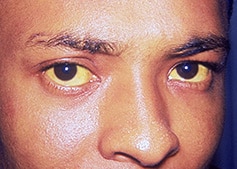Main Navigation
Hepatitis E - including symptoms, treatment and prevention
Hepatitis E is an infection of the liver caused by the hepatitis E virus.
Hepatitis E is a notifiable condition1
How hepatitis E is spread
Hepatitis E infection is spread when traces of faeces (containing hepatitis E virus) contaminate hands, objects, water or food and the virus is then taken in by mouth. Outbreaks of hepatitis E may occur and are usually caused by contaminated drinking water in areas with poor sanitation.
Hepatitis E can also be spread from a pregnant woman to her fetus and through transfusion of infected blood products.
Hepatitis E is an uncommon infection in Australia and most cases are acquired overseas.
Signs and symptoms of hepatitis E
Adults and teenagers are more likely to have symptoms. In young children, jaundice is rare and any symptoms are usually mild.
 Symptoms may include:
Symptoms may include:
- abdominal pain
- loss of appetite
- weight loss
- nausea (and sometimes vomiting)
- fever and chills
- mild headache
- tiredness
- dark urine and pale faeces
- yellow skin and eyes (jaundice) (see image).
Most people recover fully and have life-long immunity. Death from hepatitis E in non-pregnant people is rare, however, up to 20% of women infected in the third trimester of pregnancy die.
Image Courtesy Public Health Image Library (PHIL), Department of Health and Human Services, Centers for Disease Control and Prevention (CDC-USA) CDC,Dr. Thomas F. Sellers / Emory University
Diagnosis of hepatitis E
The diagnosis is based on signs and symptoms and confirmed with a blood test and/or PCR (polymerase chain reaction) test in a pathology laboratory.
Incubation period
(time between becoming infected and developing symptoms)
15 to 64 days.
Infectious period
(time during which an infected person can infect others)
Unknown.
Treatment for hepatitis E
There is no specific treatment for hepatitis E infection. Hospitalisation is not usually required.
Prevention of hepatitis E
There is currently no vaccine available for protection against hepatitis E infection. The following are recommended:
- for people with hepatitis E, the exclusion period from childcare, preschool and work is not clear but it is reasonable to recommend the same exclusion period as for hepatitis A: 7 days after the onset of jaundice or illness
- follow good personal hygiene practices, especially thorough hand washing
- always follow good food handling procedures.
In areas of the world where food and water is less safe than in Australia care is needed to minimise your chances of getting hepatitis E infection. In such areas, the following are recommended:
- do not eat raw fruit and raw vegetables unless you can peel them yourself
- cooked food that is served hot is usually safe
- only drink water that has been boiled or drink sealed bottled water
- do not use tap water to clean your teeth. Use water that has been boiled or use sealed bottled water
- do not eat ice or add ice to your drinks
- carbonated drinks from sealed containers are usually safe, if no ice is added.
Useful links
- Hand hygiene
- Protecting yourself and your health whilst travelling overseas
- Hepatitis A, B, C, D and E summary
- Handling and preparing food
- Thawing, cooking, cooling and reheating food
1 – In South Australia the law requires doctors and laboratories to report some infections or diseases to SA Health. These infections or diseases are commonly referred to as 'notifiable conditions'.